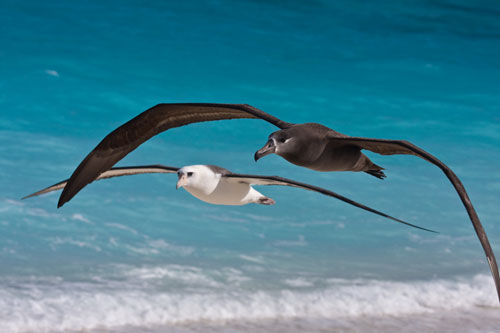 A Laysan and a Black-footed Albatross in flight; photograph by Eric Vanderwerf
A Laysan and a Black-footed Albatross in flight; photograph by Eric Vanderwerf
Yukiko Inoue (Japan Fisheries Research and Education Agency, Fisheries Resources Institute, Fisheries Stock Assessment Center, Shizuoka, Japan) and colleagues have published in the journal Ornithological Science, on an isotopic analysis of the diet of Laysan Albatross Phoebastria immutabilis and Black-footed Albatross P. nigripes in the Western North Pacific.
The paper’s abstract follows,
“In order to understand the diet of Laysan Albatross Phoebastria immutabilis and Black-footed Albatross P. nigripes in western North Pacific waters, we investigated isotopic differences between species, sexes and breeding stages. We measured carbon and nitrogen isotope ratios in the muscles and livers of albatrosses (caught during Japanese pelagic longline fishing) and in their potential prey. Both δ13C and δ15N of Black-footed Albatross were higher than those of Laysan Albatross. Delta13C of both species differed seasonally and δ13C was lower during the incubation period than during the chick-provisioning and non-breeding periods. The δ13C and δ15N levels of males did not differ from those of females in either species. Our results suggest that Black-footed Albatross forages on higher isotope prey items and/or Laysan Albatross forages on lower isotope prey items other than squid and fish and that δ13C varies in response to seasonal variation in prey availability. This implies that Black-footed Albatross forages more on discard from the fishing industry than does Laysan Albatross; this in turn may be related to the areas of operation sea area of the longline fisheries in the western North Pacific. In conclusion, it is important for conservation of these two albatross species to monitor their diets and foraging areas and to identify the species-specific high-risk areas where albatross bycatch is most likely.”
Reference:
Inoue, Y., Nakatsuka, S., Niizuma, Y., Ochi, D., Katsumata, N., Okamoto, K., Ishihi, Y., Oshima, K. & Minami, H. 2023. Stable Isotope Differences among Species, Sexes, and Breeding Stages of Laysan and Black-Footed Albatrosses in the Western North Pacific. Ornithological Science 22(1), 3-14. https://doi.org/10.2326/osj.22.3
8 February 2023

 English
English  Français
Français  Español
Español